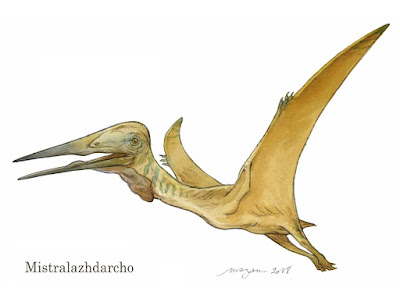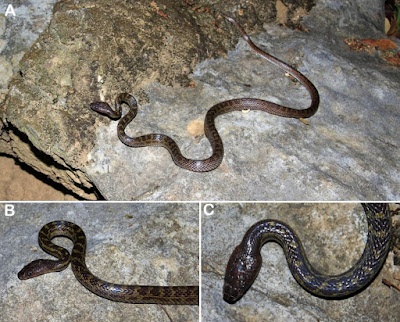[Most Recent Entries] [Calendar View]
Thursday, October 18th, 2018
| Time | Event | ||||
| 9:11a | [Paleontology • 2018] Mistralazhdarcho maggii • A New Azhdarchid Pterosaur from the Upper Cretaceous of Southeastern France
Abstract A series of pterosaur bones from the Upper Cretaceous (Campanian) of Velaux (Bouches-du-Rhône, southeastern France) is described. This material, including both cranial and postcranial elements found in close association and likely belonging to a single immature individual, is assigned to a new genus and species of azhdarchid pterosaur, Mistralazhdarcho maggii. This large-sized taxon (wingspan ca. 4.5 m in the holotype, possibly reaching 5–6 m in mature individuals) is characterized by a slightly downturned mandibular symphysis that shows a ‘V’-shaped cross-sectional profile and bears a well-developed, anteriorly located median eminence on its dorsal surface. The presence of a median eminence suggests that Mistralazhdarcho might be closely related to Alanqa from the Cenomanian of Morocco. The material described here represents the first partial skeleton of a pterosaur recovered from the Late Cretaceous deposits of western Europe, and the new taxon is one of the most completely known European azhdarchids. Mistralazhdarcho is intermediate in size between the medium-sized genus Eurazhdarcho and the giant-sized genus Hatzegopteryx, two azhdarchids from the Maastrichtian of Romania. The discovery of Mistralazhdarcho suggests the presence of a third azhdarchid size class in the continental ecosystems of the latest Cretaceous European archipelago.
SYSTEMATIC PALEONTOLOGY PTEROSAURIA Kaup, 1834 PTERODACTYLOIDEA Plieninger, 1901 AZHDARCHOIDEA Nessov, 1984 (sensu Unwin, 2003) NEOAZHDARCHIA Unwin, 2003 AZHDARCHIDAE Nessov, 1984 MISTRALAZHDARCHO MAGGII, gen. et sp. nov. Etymology: Genus name formed by a combination of ‘Mistral,’ a strong, cold, northwesterly wind blowing in southeastern France, and Azhdarcho, the type genus of the Azhdarchidae. Specific epithet in honor of Jean-Pierre Maggi, mayor of Velaux, for his support in the development of the La Bastide Neuve paleontological project. Romain Vullo, Géraldine Garcia, Pascal Godefroit, Aude Cincotta and Xavier Valentin. 2018. Mistralazhdarcho maggii, gen. et sp. nov., A New Azhdarchid Pterosaur from the Upper Cretaceous of Southeastern France. Journal of Vertebrate Paleontology. DOI: 10.1080/02724634.2018.1502670 | ||||
| 2:08p | [Herpetology • 2018] Lycodon banksi • A New Species of the Genus Lycodon Boie, 1826 (Serpentes: Colubridae) from Khammouane Province, central Laos
Abstract We describe a new species of the genus Lycodon Boie based on an adult male specimen from Khammouane Province, central Laos. Lycodon banksi sp. nov. is distinguished from its congeners by a combination of the following characters: (1) SVL 415 mm; (2) dorsal scales in 17–17–15 rows, dorsal scales on the anterior 2/3 of the body length smooth, the six central dorsal scale rows of the posterior 1/3 of the body length feebly keeled; (3) supralabials 8; (4) infralabials 10; (5) loreal in contact with the eye; (6) cloacal single; (7) ventral scales 241; (8) subcaudals 26+, paired (tail tip lost); (9) dorsal surface of body with 87 greyish yellow blotches; (10) dorsal surface of tail with 11+ light bands (tail tip lost); (11) ventral surface of body and tail uniformly grey cream. Based on the molecular comparisons, Lycodon banksi sp. nov. is placed in a clade with other species previously considered to be members of the separate genus Dinodon, except for L. futsingensis. The new species is at least about 9% genetically divergent from other species within this clade as shown by a fragment of the mitochondrial cytochrome b. Morphologically, the new species is distinguishable by its size, scalation, and colour pattern. This discovery increases the number of Lycodon species known from Laos to eleven species. Key words: New species, Lycodon, Laos, karst forest, morphology, phylogeny, taxonomy.
Lycodon banksi sp. nov. Diagnosis. Lycodon banksi sp. nov is characterized by the following morphological characters: (1) SVL 415 mm (2) dorsal scales in 17–17–15 rows, dorsal scales on the anterior 2/3 of the body length smooth, the six central dorsal scale rows of the posterior 1/3 of the body length feebly keeled; (3) supralabials 8; (4) infralabials 10; (5) loreal entering orbit; (6) cloacal single; (7) ventral scales 241; (8) subcaudals 26+, paired (tail tip lost); (9) dorsal surface of body with 87 greyish yellow blotches; (10) dorsal surface of tail with 11+ light bands (tail tip lost); (11) ventral surface of body and tail uniformly grey cream. .... Etymology. The species naming is dedicated to our friend and colleague Chris Banks, International Coordinator, Philippine Crocodile National Recovery Team, Zoos Victoria, Australia, for his outstanding contributions towards amphibian and reptile conservation, in particular of the Philippine Crocodile. We propose the following common names: Banks' Wolf Snake (English), Banks Wolfszahnnatter (German). Natural history. The specimen was found at 20:39, crawling on a limestone outcrop in the karst forest, approximately 0.3 m above the forest floor, at an elevation of 167 m a.s.l. The humidity at the time of collection was approximately 85% and the air temperature ranged from 23 to 26oC (Fig. 6). Vinh Quang Luu, Michael Bonkowski, Truong Quang Nguyen, Minh Duc Le, Thomas Calame and Thomas Ziegler. 2018. A New Species of the Genus Lycodon Boie, 1826 (Serpentes: Colubridae) from Khammouane Province, central Laos. Revue suisse de zoologie; annales de la Société zoologique suisse et du Muséum d'histoire naturelle de Genève. 125(2); 263-276. DOI: 10.5281/zenodo.1414221 |
| << Previous Day |
2018/10/18 [Calendar] |
Next Day >> |







